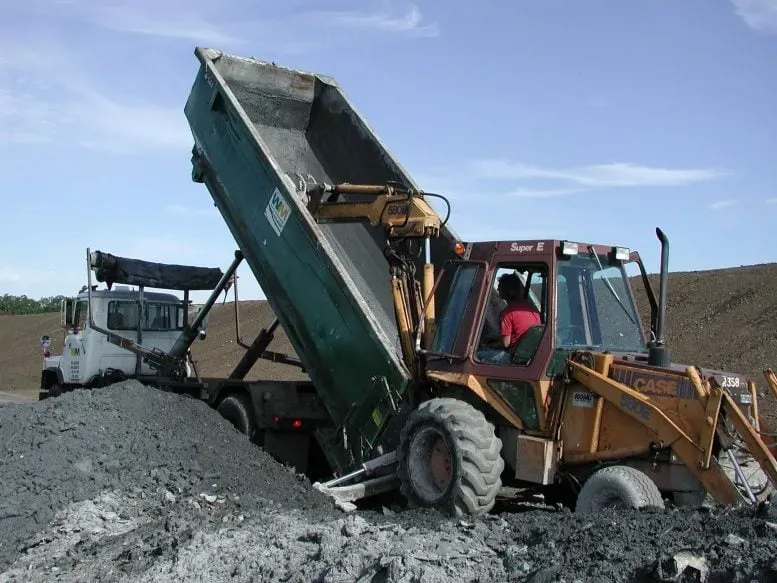Rare earth elements, often viewed as the unsung heroes of modern technology, play a pivotal role in a variety of high-tech applications, from smartphones to electric vehicles. Despite their abundance in the Earth’s crust, the extraction and processing of these critical minerals are largely concentrated in China, which has significant control over global supply. The geopolitical impact of rare earths has become increasingly pronounced, especially following recent tensions between the U.S. and China, where Beijing has threatened to limit exports in response to tariffs imposed by the Trump administration. As the U.S. grapples with its reliance on Chinese rare earth exports, the urgency to cultivate a domestic supply chain has never been greater. Understanding the complexities surrounding rare earths is crucial as they not only underpin technological advancements but also represent a critical strategic asset in the ongoing trade war.
Also known as critical minerals, rare earth elements have garnered attention as essential components in various advanced technologies and defense systems. These substances are vital for producing everything from powerful magnets used in electric motors to cutting-edge electronics, making them indispensable in today’s digital age. With the growing reliance on these minerals, countries like the United States are reevaluating their supply strategies, especially in light of China’s dominant position in the global market. This strategic reevaluation has implications not just for international trade but also for national security, as the race for innovation heats up. As production and sourcing methods evolve, the dialogue surrounding rare earths continues to shape technological pursuits and geopolitical dynamics.
Understanding Rare Earth Elements and Their Importance
Rare earth elements (REEs) are a group of 17 metals that are crucial in the production of various high-tech devices and renewable energy technologies. They include elements like neodymium, dysprosium, and terbium, which are essential for the manufacturing of powerful magnets used in electric vehicles, wind turbines, and computer hard drives. This burgeoning demand underscores the importance of REEs in the global economy, especially as the U.S. aims to transition towards cleaner energy solutions.
Moreover, the geopolitical significance of REEs has surged, as countries recognize their strategic importance in national security and technological advancements. In the context of escalating tensions between the U.S. and China, these elements have become a focal point in trade negotiations and policies. With China controlling approximately 80% of the world’s REE supply, the U.S. faces substantial risks in its supply chain for crucial technologies.
The Impact of China’s Export Restrictions on the U.S. Rare Earth Supply
In recent years, China’s export restrictions on rare earth elements have created significant challenges for U.S. industries relying on these critical materials. Following Donald Trump’s imposition of tariffs, China changed its strategy, utilizing its abundance of REEs as a bargaining chip in trade negotiations. The U.S. military and technology sectors are particularly vulnerable, as they need these materials to secure their supply chains for advanced technologies, from smartphones to missile systems.
Experts warn that China’s export limitations could lead to severe consequences for American manufacturers and defense contractors. A primary concern is that any sudden limitation on access to REEs could stall production processes, disrupt technological advancements, and even impair national defense capabilities. With China’s dominant position in the global REE market, the U.S. must develop a more robust domestic supply chain to mitigate these risks.
Geopolitical Consequences of Rare Earth Elements in U.S.-China Relations
The geopolitical landscape surrounding rare earth elements has become increasingly complex, particularly as tensions between the U.S. and China grow. Experts like Lyle Trytten have noted that the U.S.’s heavy reliance on these materials positions China in a favorable bargaining position in international negotiations. For instance, when China halted rare earth exports to Japan in 2010 amid territorial disputes, it showcased the lengths to which Beijing might go to assert its dominance in this critical sector.
Furthermore, as the U.S. implements tariffs and other restrictions targeting Chinese technology, Beijing’s countermeasures in the rare earth market could escalate into a more comprehensive trade conflict. Understanding the proactive strategies both nations employ to safeguard their critical resources is vital for policymakers who are navigating these complex and often volatile diplomatic waters. Rare earths have thus emerged as not only a component of technological development but also a significant leverage point in the geopolitical arena.
The Role of Rare Earths in Advanced Technology
Rare earth elements are indispensable in modern technology, serving as a backbone for innovations ranging from smartphones to electric vehicles. The unique properties of these materials enable the development of smaller, lighter, and more efficient devices. For instance, neodymium is crucial for creating powerful magnets used in electric motors, while dysprosium enhances the performance of hard drives crucial for data storage.
As the world’s technological dependence increases, particularly with the rise of artificial intelligence and renewable energy solutions, the demand for these elements is surging. Companies are now more than ever recognizing the potential vulnerabilities associated with relying heavily on China for their rare earth supplies. As a result, many U.S. firms are diversifying their sources and exploring alternatives to ensure they can maintain an uninterrupted flow of these essential materials.
Addressing the Challenges of U.S. Rare Earth Supply Chains
The U.S. faces significant hurdles in establishing a self-sufficient rare earth supply chain. Currently, domestic production capabilities are limited, leaving the nation at the mercy of foreign suppliers, particularly China. The complexity of processing and refining these materials adds another layer of difficulty, as the U.S. lacks the necessary infrastructure to scale these operations quickly. Experts have emphasized that even if new mining initiatives are undertaken, it may take years to develop the required facilities and expertise.
Moreover, the decline in mining engineering graduates in the U.S. poses a risk to the future of the domestic rare earth industry. Without sufficient skilled workers to manage and operate mining operations, the U.S. could miss critical opportunities to reduce its reliance on Chinese imports. This could further entrench the existing vulnerabilities in the supply chain, highlighting the urgent need for strategic investments and educational initiatives to cultivate a knowledgeable workforce.
The Economic Impacts of Rare Earth Tariffs
Donald Trump’s administration introduced tariffs on various goods in a bid to protect American industries from what was perceived as unfair trade practices by China. Among these, rare earth elements have become a focal point, as tariffs could impact both the cost and availability of essential materials for U.S. manufacturers. The economic implications are substantial; if companies cannot secure rare earths at competitive prices, the production costs for various tech products could skyrocket, ultimately affecting consumers.
Furthermore, if American manufacturers turn to alternative suppliers for rare earths outside of China, the potential increase in production costs could lead to higher prices for end-users. The long-term sustainability of U.S. industries is thus at stake, emphasizing the need for a careful balancing act between tariffs and domestic supply efforts to ensure economic viability and competitiveness in global markets.
Future Prospects for U.S. Rare Earth Mining Initiatives
The future of U.S. rare earth mining initiatives appears to be a double-edged sword. On the one hand, recent political and economic pressures may drive increased investments in domestic production capabilities. Many industry experts advocate for a diversified approach to sourcing rare earths, pushing for various mining projects to enhance resilience in supply chains. This newfound focus can empower U.S. companies to reduce their reliance on China for these critical materials.
On the other hand, significant infrastructural and technological challenges remain that could hinder progress. As Lyle Trytten highlights, the U.S. currently lacks the extensive processing facilities to efficiently handle rare earth ores. It can take years to build this essential infrastructure and develop the necessary technology to extract and refine these elements profitably. Unless substantial investments are made in this area, the timeline for achieving a self-sufficient rare earth supply chain could stretch out over a decade or more.
Innovations in Rare Earth Alternatives and Their Implications
In response to the geopolitical challenges surrounding rare earth elements, researchers and companies are exploring innovative alternatives that could reduce dependency on traditional REEs. These innovations may include new materials or technologies that replicate the functions of rare earths without the same reliance on Chinese supply chains. For example, advancements in magnet technology could allow for the development of more advanced permanent magnets that use less or no rare earth materials.
This shift towards alternatives could significantly alter the landscape of industries that depend on rare earths for production. By investing in such technologies, U.S. companies could potentially become leaders in new markets that emerge from these advancements. The drive toward exploring these alternatives not only highlights the need for sustainability but also reflects a growing awareness among manufacturers about the potential ramifications of geopolitical tensions affecting resource supplies.
The Prospect of Moon Mining for Rare Earth Elements
Looking towards the future, some experts propose the tantalizing idea of moon mining as a solution to the U.S.’s rare earth supply challenges. The moon is believed to harbor significant deposits of valuable resources, including rare earth elements. This concept has gained traction as private companies and governments invest in lunar exploration, with leading figures in the tech industry promoted this vision. By diversifying their sources to include extraterrestrial resources, the U.S. could potentially mitigate its reliance on China for rare earths.
However, the proposal of moon mining faces its own set of challenges, including the high costs of space exploration and the technical difficulties associated with extraction and transport of resources back to Earth. Additionally, regulatory and legal frameworks regarding extraterrestrial resource extraction remain ambiguous. While the potential rewards are significant, the practicality and feasibility of moon mining as a reliable source of rare earth elements necessitate careful consideration and extensive planning.
Frequently Asked Questions
What role do rare earth elements play in U.S. technology development?
Rare earth elements are crucial for various technologies, including electric vehicles, smartphone components, and military applications. The U.S. relies heavily on these materials for production, making them essential for advancing technological innovation.
How have Trump’s tariffs affected China rare earth exports?
Trump’s tariffs prompted China to impose export restrictions on rare earth elements, which are vital for U.S. industries. This escalation in trade tensions impacts the availability of these materials, exacerbating the existing dependency of the U.S. on Chinese rare earth supplies.
What is the geopolitical impact of rare earths in the U.S.-China trade war?
Rare earths have emerged as a key leverage point in the U.S.-China trade war. China’s dominant position in the production of these materials allows it to use them as a bargaining tool, impacting U.S. supply chains and national security.
Why are rare earths essential for U.S. national defense?
Rare earth elements are integral to the manufacturing of advanced defense systems, including missile systems and fighter jets. The U.S. defense industry requires these materials to ensure the functionality and superiority of its military technology.
What steps is the U.S. taking to reduce its reliance on China’s rare earth supply?
The U.S. is exploring options like developing domestic mining operations and seeking non-Chinese rare earth alternatives. However, establishing a self-sustaining supply chain is complex and may take several years to achieve.
How do China’s export controls on rare earths affect U.S. companies?
China’s export controls may initially slow rare earth exports to the U.S., creating a challenging environment for companies reliant on these materials. This could lead to increased costs and potential disruptions in their production processes.
What challenges does the U.S. face in developing its rare earth mining capabilities?
Challenges include a lack of infrastructure for mining and processing rare earths, a declining workforce in mining engineering, and high costs associated with establishing operational mines. These factors contribute to lengthy timelines for scaling up production.
Are there alternatives to sourcing rare earths from China?
Yes, alternative sources include potential mining projects in Greenland and efforts to recycle rare earth materials. However, these solutions may take time to develop and implement effectively.
How do rare earths impact the electric vehicle industry in the U.S.?
Rare earth elements are vital for electric vehicle motors, allowing for efficiency and performance. As the demand for electric vehicles grows, U.S. companies face increasing pressure to secure reliable access to these materials.
What are the future prospects for U.S. rare earth supply chains?
The U.S. aims to diversify its rare earth supply chains, but the transition will take years. Investments in domestic production and innovation are crucial to reducing dependence on Chinese rare earth exports.
| Key Points |
|---|
| China’s tariffs and export restrictions on rare earth elements affects U.S. industries, particularly in defense and technology. |
| Rare earth elements are vital for weaponry, electric vehicles, and computing technologies. |
| China dominates the rare earth supply chain, making the U.S. reliant on Chinese imports. |
| The U.S. is years away from achieving its own supply chain for rare earths. |
| China balances its economic interests with geopolitical strategies regarding rare earth exports. |
| The U.S. response might include exploring alternative sources, including mining in Greenland. |
| Experts predict that exporting rare earths will initially slow down due to new regulations. |
| Investments are needed to reduce the U.S. dependence on Chinese rare earth materials. |
| Experts warn that lack of mining expertise could slow the development of new domestic sources. |
Summary
Rare earth elements are crucial materials that play a significant role in many modern technologies and defense systems. As the trade tensions between the U.S. and China escalate, these elements have become a focal point of leverage for China, highlighting the U.S.’s vulnerability due to its dependency on Chinese imports. The situation underscores the urgent need for the U.S. to develop a resilient supply chain for rare earths, seeking alternatives and investments to break free from reliance on China.



